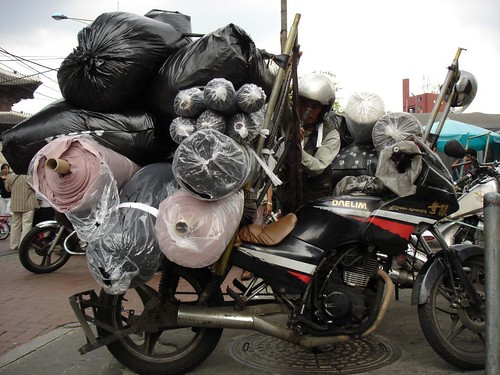What a great Thanksgiving weekend! Today Juli and I decided to go on a short hike up Blue Job Mountain, not far from us in NH. It's a little mountain, and the trail isn't long, but its unique position means great views in all directions. You can see into the White Mountains, East to Maine, bits of the seacoast, and West toward Vermont.
Anyway, despite today's late November date, the weather was nice, mid 40s and sunny. So we took the Honda! The picture above is Juli and the Honda at the trail head. We wore many layers! On the way there, a couple of the roads we wanted to take turned out to be dead-ends. The Honda has seen some mild off road duty, and handles it well, but I didn't think we'd make these ones, especially with two on the bike.
What a great ride, though! We found some great roads we've never been on. It's interesting to ride when all the leaves are gone because you see things you wouldn't notice in the summer. For example, the view of Bow Lake from Province Road was beautiful! Somewhere in Strafford we were behind an old, gray Jeep CJ7. The sounds and smells from that jeep filled me with great memories. We always had cj's growing up, and sound of the 258ci straight six engine of the AMC era jeeps is one of the more enduring memories I have kept from childhood.
It was a great day, and probably our last ride of the season. When we got home I added Stabil to the gas tank and parked the bike in the tent behind the garage. Sad, but the reality is that we may not see many more days above 40 degrees, and that's cold enough for me. From now until Spring the focus will be the repairs and maintenance items listed in the older post.
On another note, we made some great discoveries in the luggage realm. First off, on our way back from Thanksgiving dinner Juli and I stopped at a bike dealer in Maine. I have been wanting to see the new Moto Guzzi V7 in person since it came out, so we made a special stop. That bike, by the way, is absolutely beautiful. The perfect size, stance, style. I was thoroughly impressed! Anyway, at the dealer we saw a nice little top trunk from EMGO that looks to be the perfect size for our rear rack.

Best of all it's relatively cheap! I looked at some nice cases from name brands and they're great, but many of them cost over $200! It was great to see this trunk in person and witness just how sturdy it was.
Speaking of cheap, we had a new idea for side cases as well, and it came from the redneck world of Cabelas! Don't get me wrong, I like Cabelas; in fact our tent came from them and it is excellent!
There is lots of talk on the adventure rider's forum about using ammo cans for side cases. It's cheap and easy, but those things are very heavy, and our little bike can't carry a ton of extra weight. And as much as I like the Pelican style boxes I mentioned before, they are pretty heavy too. That's why I like these plastic boxes from Cabela's:
They're called Magnum Field Boxes, made by a company called Plano. They appear to be rather tough, light, and are bigger than the Pelican's I was looking at. They're also top-loading, which could be handy. These are also cheap, around $25!! Next time we're in Maine, we'll stop at the Cabela's store and see them in person. That way we can judge whether they'd be tough enough for what we want to do.
Also, this weekend we looked at some travel books and I found one that I really like from National Geographic. It's their guide to scenic highways and biways. As a gauge for the quality of routes described, I looked at the New Hampshire section. They mentioned Route 302 and the Kancamangus Highway, as they should. But they also mention Route 153, which snakes up the east side of the state. My dad discovered this road on his Royal Enfield and raved about it. It is off the beaten path, but a great ride, so it seems that National Geographic is good at judging great routes! It will be a great tool for finding those small, twisty, hilly, narrow roads we hope to stick to on our trip.
Hope everyone's Thanksgiving was great. With all this planning and fun we had this weekend, Juli and I both feel thankful.
Seeya
Jeremy B

















